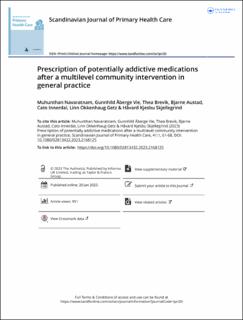| dc.contributor.author | Navaratnam, Muhunthan | |
| dc.contributor.author | Vie, Gunnhild Åberge | |
| dc.contributor.author | Brevik, Thea Beate | |
| dc.contributor.author | Austad, Bjarne | |
| dc.contributor.author | Innerdal, Cato | |
| dc.contributor.author | Getz, Linn Okkenhaug | |
| dc.contributor.author | Skjellegrind, Håvard Kjesbu | |
| dc.date.accessioned | 2023-09-27T07:11:38Z | |
| dc.date.available | 2023-09-27T07:11:38Z | |
| dc.date.created | 2023-01-30T14:54:44Z | |
| dc.date.issued | 2023 | |
| dc.identifier.citation | Scandinavian Journal of Primary Health Care. 2023, 41 (1), 61-68. | en_US |
| dc.identifier.issn | 0281-3432 | |
| dc.identifier.uri | https://hdl.handle.net/11250/3092211 | |
| dc.description.abstract | Objective: To evaluate the long-term effects of a multilevel community intervention to improve the quality of prescription practice of potentially addictive medications (PAMs). Design: We conducted a retrospective study, using anonymized data from the Norwegian prescription registry. Setting: Based on an initiative from the GPs in Molde Municipality in Norway, a multilevel community intervention was initiated by the municipal chief physician in 2018. The intervention targeted GPs, patients, and the public. Subjects: We retrieved prescription data from 26 of 36 GPs. Main outcome measures: By using the standardized defined daily dose (DDD), we compared prescription of three groups of PAMs from before the intervention (2017) throughout the intervention in 2018, and through 2020 to determine long-term effects. Results: Three years after the intervention, the GPs in our study sample prescribed 26% less opioids, 38% less benzodiazepines, and 16% less z-hypnotics. Overall prescription of PAMs decreased by 27%. The number of individuals receiving at least 90 DDD of benzodiazepines and z-hypnotics were reduced from 9 to 7 and 34 to 24 per 1000, respectively. Also, the number of individuals receiving two and three PAMs concomitantly were reduced. Conclusion: Addressing prescription practice among GPs in a community as a joint intervention, combined with addressing patients and the public may be a feasible method to obtain long-term reduction of PAM prescriptions. Keywords: Opioid, benzodiazepine, z-hypnotic, tapering, inappropriate prescribing, polypharmacy, public health | en_US |
| dc.language.iso | eng | en_US |
| dc.relation.uri | https://doi.org/10.1080/02813432.2023.2168125 | |
| dc.rights | Navngivelse 4.0 Internasjonal | * |
| dc.rights.uri | http://creativecommons.org/licenses/by/4.0/deed.no | * |
| dc.title | Prescription of potentially addictive medications after a multilevelcommunity intervention in general practice | en_US |
| dc.type | Peer reviewed | en_US |
| dc.type | Journal article | en_US |
| dc.description.version | publishedVersion | en_US |
| dc.source.pagenumber | 61-68 | en_US |
| dc.source.volume | 41 | en_US |
| dc.source.journal | Scandinavian Journal of Primary Health Care | en_US |
| dc.source.issue | 1 | en_US |
| dc.identifier.doi | 10.1080/02813432.2023.2168125 | |
| dc.identifier.cristin | 2118635 | |
| cristin.ispublished | true | |
| cristin.fulltext | original | |
| cristin.qualitycode | 1 | |

